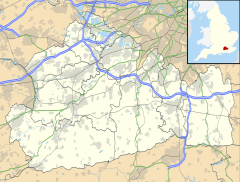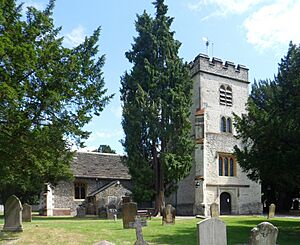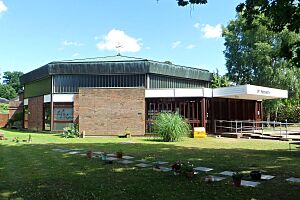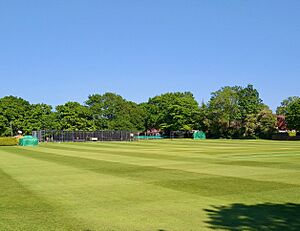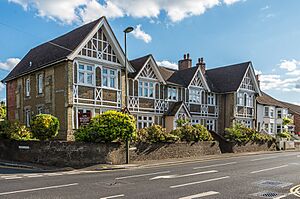Ashtead facts for kids
Quick facts for kids Ashtead |
|
|---|---|
| Village | |
 Ashtead Park House, a school since the 1920s |
|
 Barnett Wood Lane with pond to the right |
|
| Area | 11.59 km2 (4.47 sq mi) |
| Population | 14,169 (2011 census) |
| • Density | 1,223/km2 (3,170/sq mi) |
| OS grid reference | TQ1858 |
| Civil parish |
|
| District |
|
| Shire county | |
| Region | |
| Country | England |
| Sovereign state | United Kingdom |
| Post town | Ashtead |
| Postcode district | KT21 |
| Dialling code | 01372 |
| Police | Surrey |
| Fire | Surrey |
| Ambulance | South East Coast |
| EU Parliament | South East England |
| UK Parliament |
|
Ashtead is a village in Surrey, England. It is about 25 kilometers (16 miles) south of central London. Ashtead is located on the A24 road between Epsom and Leatherhead. The village sits on the northern slopes of the North Downs. It is also near The Rye, a small river that flows into the River Mole.
People have lived in Ashtead since the Stone Age. For a long time, even during the early Roman period, Ashtead was known for making bricks and tiles. From the Middle Ages until the late 1800s, Ashtead was mostly a farming village.
The village grew a lot after the railway line opened in 1859. More homes were built, especially in the 1930s. Today, new building is limited by the Metropolitan Green Belt. This is a protected area of land around London.
Ashtead has two special nature areas. Ashtead Common is a large woodland owned by the Corporation of London. Ashtead Park is a Local Nature Reserve owned by the local council.
Contents
- What's in a Name? The History of Ashtead's Name
- Exploring Ashtead's Location and Landscape
- Ashtead Through the Ages: A Brief History
- Public Services in Ashtead
- Ashtead's Industries and Businesses
- Getting Around: Transport in Ashtead
- Learning in Ashtead: Schools and Education
- Places of Worship in Ashtead
- Culture and Arts in Ashtead
- Sports and Recreation in Ashtead
- Green Spaces: Parks and Nature Reserves
- Famous Buildings and Landmarks in Ashtead
- Ashtead Park House: A Grand Home
- Coal-Tax Posts: Historical Markers
- Feilding House: Almshouses for Widows
- Grey Wings: A Unique House
- Leg of Mutton and Cauliflower Pub: An Old Inn
- Memorial Fountain: Honoring Mary Howard
- Peace Memorial Hall: A Community Space
- Public Library: For Reading and Learning
- Village Club: A Social Spot
- Whittaker's Cottages: Moved for History
- Famous People from Ashtead
- See also
What's in a Name? The History of Ashtead's Name
The name Ashtead has changed over time. In a very old book from 1086, called the Domesday Book, it was called Stede. This simply meant "place".
Later, it was known as Estede, Akestede, and Aschestede. The name Ashtead likely means "place of ash trees".
Exploring Ashtead's Location and Landscape
Where is Ashtead Located?
Ashtead is a big village in the Mole Valley area of Surrey. It is about 25 kilometers (15.5 miles) south of central London. The village is on the southern edge of the London Basin. The highest point in Ashtead is about 130 meters (426 feet) above sea level.
Both the Epsom to Leatherhead railway line and the A24 road pass through Ashtead. They run roughly parallel to The Rye river.
Understanding Ashtead's Areas
The old part of Ashtead is called "The Village". This area has the main shops along The Street (A24). The area closer to the railway station is called "Lower Ashtead". It has its own shops too.
Ashtead has two important nature spots. Ashtead Common is a 181-hectare (447-acre) woodland. It is managed by the City of London Corporation. Ashtead Park is 54 hectares (133 acres) and is owned by Mole Valley District Council.
How Ashtead's Geology Shaped It
Ashtead is a "spring line settlement". This means it is built where water naturally comes to the surface. This happens where the chalk of the North Downs meets the London Clay. Chalk holds water like a sponge. Many wells were dug here for drinking water.
Springs flow from this area, feeding The Rye river and its smaller streams. They also fill the ponds on Ashtead Common and in Ashtead Park.
Ashtead Through the Ages: A Brief History
Early Times: Pre-history to Roman Era
The first signs of people living here are from the Paleolithic and Mesolithic periods. Tools made of flint have been found, some as old as 50,000 years. Pottery from the Neolithic period (New Stone Age) was also found. Bronze Age items like a spearhead have been discovered.
Ashtead was a big center for making Roman bricks and tiles in the 1st and 2nd centuries AD. There was a Roman villa and kilns (ovens for firing bricks) next to clay pits. Workers even had a bath house. These ancient sites are now protected.
The bricks and tiles were likely moved by a short road to Stane Street. This was a main Roman road nearby. Roman life in Ashtead may have continued into the 4th century.
Medieval Ashtead: From Domesday to Tile Making
In the 1086 Domesday Book, Ashtead was called Stede. It was owned by the Canons of Bayeux. The village had land for farming and woodland.
Later, the de Warenne and de Montfort families owned the manor. Ashtead men even fought in the Second Barons' War in the 1260s. The manor changed hands many times until it went to the Crown in 1543.
Tile making happened again on Ashtead Common in the late 1300s. A person called "Henry the Tyler of Asshstede" supplied many roof tiles. This medieval tile factory likely closed around 1400.
Early Modern Period: Pepys and Country Estates
In the mid-1600s, Ashtead was still a farming village. Land was divided into strips for families to farm. The famous diarist Samuel Pepys visited Ashtead in 1663. He remembered his childhood walks there.
The Howard family owned Ashtead for much of this time. Sir Robert Howard bought the manor in 1680. He built a new mansion and created a formal garden. Important guests like King Charles II visited his home.
By 1755, a turnpike road (a toll road) was built through Ashtead. This connected Epsom and Horsham. Stagecoaches used this road daily.
The 19th Century: Railways and Growth
For most of the 1800s, Ashtead was a farming area. Mary Howard, who owned the manor, helped the village a lot. She started St Giles' School and helped build almshouses. She also helped improve the parish church.
In 1838, the common fields were divided into smaller, private fields. This changed how farming was done. More land was sold for building homes around 1850.
The railway line opened in Ashtead on February 1, 1859. At first, Ashtead railway station was small, with only one platform. Trains only stopped if someone asked. This railway made it easier for people to travel to London.
After Mary Howard died in 1877, much of the village land was sold. New houses started to appear, and Ashtead's population grew from 906 in 1871 to 1,881 in 1901.
The 20th Century: Wars and Modern Development
Ashtead continued to grow in the early 1900s. Many new homes were built, especially in the west of the village. By 1911, the population reached 2,921. Many new residents traveled to London for work by train.
During World War I, soldiers were stationed in Ashtead. They helped build a hospital in Epsom. George V visited the troops in 1914.
The years between the two World Wars saw the fastest growth. The railway line was electrified in 1925, making the village even more appealing. The population jumped from 3,226 in 1921 to 9,336 in 1939.
In World War II, children were sent to Ashtead for safety. Soldiers were also based here. The village was hit by some bombs and rockets during the war.
After the war, much of the land around Ashtead became part of the Metropolitan Green Belt. This protected area stopped the village from growing too much.
Public Services in Ashtead
Utilities: Water, Gas, and Electricity
Before the late 1700s, people in Ashtead got water from the river or from wells. In 1884, the first piped water system was installed. Gas for street lighting arrived in the 1880s. The first sewerage system was finished in 1900, and electricity came to Ashtead in the same year.
Emergency Services: Keeping Ashtead Safe
In the early 1800s, a local constable kept order. The Leg of Mutton and Cauliflower pub even served as a temporary village prison. In 1851, the Surrey Constabulary took over policing.
Ashtead Fire Brigade started in 1901. It later joined with Leatherhead's fire service in 1926. Today, the Surrey Fire and Rescue Service protects the village. Local ambulance services are provided by the South East Coast Ambulance Service.
Healthcare in Ashtead
Ashtead Hospital is a private hospital that opened in 1984. The nearest hospital with an A&E (Accident and Emergency) is Epsom Hospital. Ashtead also has two local doctor's offices.
Ashtead's Industries and Businesses
Brick and Tile Making History
Ashtead has a long history of making bricks and tiles. Clay pits on Ashtead Common were used by Romans and in medieval times. In the 1800s, several brickworks operated in the village. Houses were later built on these sites.
Ashtead Potters Ltd

Ashtead Potters Ltd was a company started in Ashtead in 1923. They made many different pottery items. The clay was brought to Ashtead by train. The company closed in 1935 because of low sales during the Great Depression.
Modern Businesses
The Ashtead Group was founded in 1947. It started as a company that rented out equipment. Today, it is a large international company that rents equipment in Canada, the United States, and the United Kingdom.
Getting Around: Transport in Ashtead
Road Travel
The A24 road goes through the center of Ashtead. In 1985, Ashtead became connected to the UK motorway system when the M25 motorway opened nearby.
Bus Services
Local bus routes connect Ashtead to nearby towns. Route 408 goes between Epsom, Leatherhead, and Cobham. Route 479 travels from Epsom to Leatherhead and Guildford.
Train Services
Ashtead railway station is located northwest of the village center. It is managed by Southern. Trains from Ashtead go to London Victoria and London Waterloo. You can also catch trains to Horsham and Guildford.
Walking Paths
The Thames Down Link is a long-distance walking path. It runs through Ashtead Park, connecting Kingston upon Thames to Box Hill.
Learning in Ashtead: Schools and Education
Local Schools for All Ages
The first school in Ashtead was started by the Howard family in 1815. St Giles' Infant School opened in 1852. Barnett Wood Infant School opened in 1906. The Greville Primary School opened in 1958, and West Ashtead Primary School opened in 1964.
St Andrew's Catholic Secondary School is located near Ashtead's southern border in Leatherhead.
Independent Schools in Ashtead
The City of London Freemen's School moved to Ashtead Park in 1926. It was founded in 1854 to educate orphans. It is one of the oldest schools in the world that teaches both boys and girls together.
Downsend Lodge (Ashtead) started as Ryebrook School in 1948. It is now a school for younger children.
Schools That Are No Longer Open
Parsons Mead School was an independent school for girls. It opened in 1897 and closed in 2006. The land was then sold for housing.
Places of Worship in Ashtead
St Giles' Church: A Historic Landmark
St Giles' Church is first mentioned in a document from the early 1100s. It was built around 1115. The oldest part is the east end of the nave. This wall even includes some old Roman tiles!
The chancel was added in the 1200s. The church was rebuilt in the 1400s and 1500s, when the tower was added. It has a special east window from the 1500s. The churchyard has war graves from both World Wars.
St George's Church: A Community Hub
A small church was built in Lower Ashtead in 1882. The current brick building for St George's Church was started in 1905 and opened in 1906. It has been expanded over the years. A new east window was added in 1961.
St Michael's Catholic Church
Catholic services in Ashtead began in 1942. The foundation stone for St Michael's Catholic Church was laid in 1967. The church was completed in October of the same year.
Ashtead Baptist Church
The Baptist Church started as the Ashtead Gospel Church in 1895. It became the Ashtead Free Church in 1913. A permanent brick building was built in 1924.
Culture and Arts in Ashtead

Ashtead Choral Society was formed in 1949. They perform concerts regularly in local places. In 2008, they asked a composer to write "The Ashtead Psalms" for their 50th anniversary.
Sports and Recreation in Ashtead
Ashtead is home to several sports clubs. Ashtead Cricket Club started in 1887. They play their home games at Woodfield Lane. The Old Freemen's Cricket Club also plays in Ashtead.
Ashtead Football Club was founded in 1894. They now play their home games at the Recreation Ground.
The Old Freemen's Ladies' hockey team plays on an artificial pitch in Ashtead Park. Rugby Union has been played in Ashtead Park since 1930 by the Old Freemen's RFC.
Green Spaces: Parks and Nature Reserves
Ashtead Common: A Woodland Haven
In medieval times, Ashtead Common was open land used for grazing animals. Trees were also cut for wood. After World War II, the Common became a Site of Special Scientific Interest. It is now owned by the Corporation of London.
Today, Ashtead Common is about 200 hectares (494 acres). It has public footpaths and bridleways. It is home to 90 different bird species, including tawny owls and green woodpeckers. It also has many rare types of beetles.
Ashtead Park: A Local Nature Reserve

Ashtead Park was created as a 200-acre deer park in the late 1600s. The northern part of the park, with its oak trees and two large ponds, is now a local nature reserve. It is managed by Surrey Wildlife Trust.
Ashtead Rye Meadows: Restoring Nature
The Ashtead Rye Meadows are privately owned land west of the village. They became a Site of Nature Conservation Interest in 2013. This 48-acre (19-hectare) site runs along The Rye river.
In the Middle Ages, part of this area was a "Great Marsh." The river's path was straightened in the 1950s, which harmed wildlife. Volunteers worked to restore the river in the 2010s, bringing back its natural curves.
Recreation Ground: A Place to Play
The Recreation Ground in Barnett Wood Lane opened in 1932. It is a popular spot for sports and outdoor activities.
Famous Buildings and Landmarks in Ashtead
Ashtead Park House: A Grand Home
Ashtead Park House was designed by Joseph Bonomi the Elder. It was finished in 1790. It is made of yellow bricks with special stone details. The house was made bigger around 1880. It has a round drawing room and a grand staircase. The building is now a Grade II* listed building. It is part of the City of London Freemen's School.
Coal-Tax Posts: Historical Markers

Six old coal-tax posts can be found along the northern edges of Ashtead. These posts marked where a tax on coal began. They were put up in 1861. Most are made of cast iron and painted white.
Feilding House: Almshouses for Widows
The almshouses in The Street were built thanks to a gift from Lady Diana Howard in the 1700s. They are called Feilding House. Originally, they housed six widows. Later, they were changed to fit eight residents.
Grey Wings: A Unique House
Grey Wings is a house designed by famous architects Giles Gilbert Scott and his brother Adrian. It was built in 1913. It is a Grade II listed building. The house has changed very little since it was built.
Leg of Mutton and Cauliflower Pub: An Old Inn
The oldest parts of the Leg of Mutton and Cauliflower pub date back to the late 1600s. An innkeeper was first recorded here in 1707. The building has a wooden frame. It is protected by a Grade II listing.
Memorial Fountain: Honoring Mary Howard
The Memorial Fountain was put up in 1879. It honors Mary Howard, who helped the village a lot. It is made of sandstone and looks like a medieval cross.
Peace Memorial Hall: A Community Space
The Peace Memorial Hall in Woodfield Lane was built to celebrate the end of World War I. This single-story building opened in 1924. It serves as a village hall for community events.
Public Library: For Reading and Learning
The library in Woodfield Lane is run by Surrey County Council. The brick building was designed by RJ Ash and opened in 1968.
Village Club: A Social Spot
Ashtead Village Club started in 1887 as a social club for men. It offered entertainment other than pubs. The club moved to its current location in 1888. The building was damaged in 1941 and rebuilt. The current building opened in 1966. Women became full members in 2008.
Whittaker's Cottages: Moved for History
Whittaker's Cottages were built near the railway line in the 1860s. They were small, two-story homes made mostly of wood. In 1987, the cottages were taken apart. They were then moved and rebuilt at the Weald and Downland Living Museum in West Sussex.
Famous People from Ashtead
- Samuel Pepys (1633–1703) visited Ashtead in the 1600s and lived there as a boy.
- Thomas Tyers (1726–1787) was an author.
- Thomas Byam Martin (1773–1854) was a Royal Navy officer and politician.
- Sara Jeannette Duncan (1861–1922) was a Canadian author and journalist.
- Robert Kahn (1865–1951) was a composer who lived in Ashtead.
- Robert Davis (1870–1965) invented special escape equipment for submarine crews.
- Elsie Knocker (1884–1978) was a nurse and ambulance driver during World War I.
- Albert Marshall (1897–2005) was the last surviving British cavalryman from World War I.
- Beverley Nichols (1898–1957) was a writer and composer.
- A. P. Herbert (1890–1971) was a writer and politician.
- Kathleen Riddick (1907–1973) was a pioneering conductor.
- Pete Brown (1940–2023) was a poet and lyricist.
- Evan Davis (born 1962) is a journalist and TV presenter who grew up in Ashtead.
See also
 In Spanish: Ashtead para niños
In Spanish: Ashtead para niños


